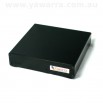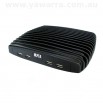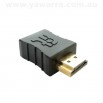This is a list of definitions of some of the common terms and acronyms used around our site.
Please contact us if you’d like to explain anything further for you.
- 802.11
- 802.11 (or WiFi) refers to a set of wireless communication standards as developed by the IEEE LAN/MAN Standards Committee (IEEE 802). The most commonly used protocols are 802.11a, 802.11b, 802.11g and 802.11n.
- ACMA
- The Australian Communications and Media Authority is the government body in Australia that is responsible for the regulation of broadcasting, radiocommunications, telecommunications and online content.
- ALIX
- The ALIX is a small form factor, single board computer developed by PC Engines in Switzerland, intended for use in embedded and wireless devices.
- AUD
- AUD is an abbreviation for the Australian dollar.
- CCK
- Complementary code keying is a modulation (or signal encoding) technique for data transmission and is used by 802.11b. Modulation varies a carrier signal in order to encode information. CCK is a variation of CDMA (a multiplexing technique used in mobile telecommunications) and is slower than OFDM.
- CF
- Compact Flash is a type of memory used in storage devices. Compact Flash cards are solid state storage devices designed for use in electronic equipment, including cameras and computers. Their data is not lost when the power is turned off and they are designed to cope with rough treatment, unlike the average hard drive. They are small and lightweight and have no moving parts, which minimises noise and power usage. CF cards can be Type I or Type II.
- CM9
- The CM9 is a miniPCI wireless adapter, developed by Wistron Neweb in Taiwan. It is based on the Atheros 5004 reference design. It supports the 802.11a, 802.11b and 802.11g wireless standards.
- Cornucopia
- A cornucopia is an abundant or overflowing supply.
- CPE
- Client (or customer) premises equipment is the equipment installed in a customer’s residence or workplace that allows them to gain access to a wireless ISPs network.
- dBi
- dBi stands for decibels over isotropic and is the unit of measure for the gain of an antenna.
- dBm
- dBm stands for decibels referenced to 1 milliwatt (mW) and is the unit of measure for the absolute power output of a wireless system.
- DIN rail
- A DIN rail or top-hat rail is a standardised 35 mm wide metal rail with hat-shaped cross section. It is widely used for mounting circuit breakers and industrial control equipment inside equipment racks.
- DVI
- DVI stands for Digital Visual Interface, and refers to a video interface standard designed to provide very high visual quality on digital display devices.
- Eber
- Our name for our range of small form factor computers with a bit more “grunt”. Eber is also the German word for ‘boar’. The Eber servers are no longer available.
- EIRP
- Equivalent (or Effective) Isotropic Radiated Power is the power that would have to be emitted by an isotropic antenna to produce the same power as produced by a real-life antenna, taking into account the power output of the wireless adapter, the gain of the antenna and signal losses in the cabling between the two.
- Embedded
- An embedded computer is one that performs a limited set of tasks, in contrast to personal computers (PCs) which are general-purpose computers. Embedded computers are rarely accessed via a keyboard or a mouse, instead they are fully contained within the device they control, such as a portable music player, a mobile phone or a wireless access point.
- eSATA
- eSATA is a variation of the SATA standard, established in 2004, that allows for external connectivity. In other words, eSATA is a way of connecting an external SATA hard drive.
- FDD
- FDD stands for floppy disk drive.
- fit-PC2
- The fit-PC2 is an ultra small desktop computer, with extremely low power usage, capable of running Windows and Linux. At just 27 x 110 x 115mm, and using only 6-9W at full load, this is the world’s smallest energy efficient computer.
- fit-PC3
- The fit-PC3 is an ultra small desktop computer, with extremely low power usage, capable of running Windows and Linux. At just 25 x 160 x 160mm, and using only 15-20W at full load, this is one very powerful, yet very energy-efficient computer.
- Gain
- Antenna gain is the way in which an antenna redistributes and focuses the output power of a wireless card, relative to an antenna with isotropic radiation. Gain is measured in dBi.
- GHz
- Gigahertz is a unit of frequency. One hertz is ‘one cycle per second’ and giga means 109 or 1 billion. Radio waves used for wireless technology are usually measured in GHz or MHz (1 million cycles per second).
- GPIO
- A general purpose input/output interface is often used in embedded devices, and offers a set of IO ports which can be configured for either input or output.
- GST
- The Goods and Services Tax is Australia’s sales tax system, applied to all goods and services sold in Australia, except for certain items such as food and medical services. The current rate of GST is 10%. Goods shipped to locations outside of Australia are not subject to GST.
- HDD
- HDD stands for hard disk drive.
- HDMI
- HDMI stands for High-Definition Multimedia Interface, which is a compact audio/video interface standard for transmitting uncompressed digital data.
- IDE
- IDE is an acronym for Integrated Drive Electronics which is a standard interface for connecting storage devices such as hard disks and CD-ROM drives to PC compatible computers. IDE is also known as PATA, ATA and ATAPI.
- Intense PC
- The Intense PC is a high-powered, energy-efficient desktop computer developed by CompuLab in Israel. With a 2nd Generation Intel Core i7 Processor and up to 16 GB dual channel DDR3-1333, it will provide blazing fast performance that has never been seen before on a miniature fanless system.
- IP67
- An IP (ingress protection) rating describes the degree of protection that a case provides for the enclosed electronic equipment. The first number refers to the protection against solid objects and the second against liquids. Our ALIX 3 Outdoor cases are IP67 rated which means the ALIX 3 boards are totally protected against dust and protected against the effect of immersion between 15cm and 1m.
- I-PEX
- I-PEX is a type of connector found on wireless cards, used for attaching a pigtail. It is essentially identical to u.fl.
- Isotropic antenna
- An isotropic antenna is a theoretical ideal in which power is radiated uniformly in all directions, forming a sphere. The isotropic antenna is used as a reference for determining the gain of an antenna. See also ‘frictionless pulley’ and ‘massless spring’ ;)
- ISP
- An internet service provider provides access to the internet for individuals and businesses.
- LAN
- A Local Area Network is a computer network that covers a small physical area, usually a room or a building.
- LCD
- A liquid crystal display (or LCD) is a type of video screen that uses light-modulating liquid crystals arrayed in front of a light source to produce images. LCDs are more energy efficient and safer to dispose of than the older style cathode ray tube (CRT) displays.
- LLC
- Low-loss cable (or LMR) is a special kind of cable used in pigtails to minimise signal loss over long distances (eg 2m or 5m).
- Mbps
- Mega bits per second (or Mbits/s) is a unit of measure of data transfer rates. It is equivalent to 1 million bits per second.
- MIMO
- Multiple Input Multiple Output (or MIMO) is a method of combining existing wireless encoding standards by using more than one antenna, across both the 2.4GHz and 5.8GHz frequency bands, to create ultra-high speed wireless networking.
- miniPCI
- miniPCI (or mini-PCI) is a form factor for expansion cards for small computers. It is a modification of the PCI card format. miniPCI cards can be Type I, II or III, with differences in size and connectors. All of our miniPCI cards are type IIIA (3A) or IIIB (3B). miniPCI and PCI cards are interchangeable when used with an appropriate adapter.
- miniPCI Express
- miniPCI Express (or Mini PCIe) is a replacement for the Mini PCI form factor, based on PCI Express. It is a modification of the PCI Express card format, to allow the use of smaller form factor expansion cards in compact desktops and servers.
- mSATA
- mSATA (or mini-SATA) is a variant of the SATA standard, intended for netbooks and other devices that require a smaller solid-state drive. mSATA uses a connector that is similar in appearance to a mini-PCI Express interface, and is electrically compatible, but needs the data signals to be sent to the SATA host controller instead of the PCI host controller. mSATA can be used to connect mSATA storage devices that are much smaller than a regular 2.5″ hard drive or SSD.
- net4801
- The net4801 is a small form factor, single board computer developed by Soekris Engineering in the USA, intended for use in embedded and wireless devices. It is no longer being produced.
- net5501
- The net5501 is a small form factor, single board computer developed by Soekris Engineering in the USA, intended for use in embedded and wireless devices.
- net6501
- The net6501 is a small form factor, single board computer developed by Soekris Engineering in the USA, intended for use in embedded and wireless devices.
- nuxV
- The nuxV 1600 is a small and powerful dual board rackmount server developed by Yawarra Information Appliances, based on the IPC100 boards from OpenVox.
- OFDM
- Orthogonal frequency-division multiplexing is a modulation (or signal encoding) technique for data transmission and is used by 802.11a and 802.11g. Modulation varies a carrier signal in order to encode information. OFDM is a complex technique based on frequency-division multiplexing (used in radio, television and telephone communications) and is faster than CCK.
- Omni
- The term omni is used to describe omni-directional antennas. Omni antennas generally radiate power in a pancake shape perpendicular to their length.
- OS
- Depending on the context, OS (or O/S) can stand for operating system or open source.
- PC
- A personal computer is the kind of computer found on a desk, usually a desktop computer or a laptop, and intended for personal use. Most often, it refers to an IBM PC compatible computer.
- PCI
- The Peripheral Component Interconnect is a standard for the connection of peripheral devices, usually expansion cards or integrated circuits, to a motherboard. There are many PCI expansion cards available, including modems and network cards, as well as variants such as miniPCI and CardBus.
- PCI Express
- Peripheral Component Interconnect Express (or PCIe) is a computer expansion bus standard designed to replace the older PCI, PCI-X, and AGP bus standards, and is used for the connection of peripheral devices, usually expansion cards or integrated circuits. Compared to the older standards, PCIe has a higher maximum system bus throughput, lower I/O pin count and smaller physical footprint, better performance-scaling for bus devices, a more detailed error detection and reporting mechanism, and native hot-plug functionality.
- PPOE
- Passive Power Over Ethernet is a way to provide electrical power to a device using a standard ethernet cable. This saves the need for a separate power cable, and is especially useful for computers that are remote, or in hard-to-access locations. Passive power over ethernet is not IEEE 802.3af compliant, as it does not interact with a POE switch to tell it what voltage it requires.
- Proforma invoice
- A proforma invoice is basically a draft invoice (like a quote, but for an actual order), which we send you if you need an invoice before you can pay for an order. It gives you a chance to check the invoice details, such as delivery address, freight charges and product options, quantities and pricing. When you’re happy with the invoice, you make payment, and we then email you an official tax invoice (or a commercial invoice) when we ship the goods.
- RAM
- Random Access Memory refers to the main memory of a computer, used for data processing.
- RoHS
- Restriction of Hazardous Substances is a scheme in the European Union which limits the levels of lead, cadmium, mercury, hexavalent chromium, polybrominated biphenyl (PBB) and polybrominated diphenyl ether (PBDE) flame retardants in new electrical and electronic equipment.
- RS232
- RS232 or RS-232 is a standard for serial binary single-ended data and control signals connecting between a DTE (Data Terminal Equipment) and a DCE (Data Circuit-terminating Equipment). It is commonly used in computer serial ports.
- SATA
- SATA is an abbreviation for Serial ATA (or Serial Advanced Technology Attachment), and is a computer bus interface for connecting mass storage devices such as hard disk drives and optical drives. Serial ATA was designed to replace the older parallel ATA (or IDE) standard, offering reduced cable size and cost (7 conductors instead of 40), native hot swapping, faster data transfer through higher signalling rates, and more efficient transfer through an (optional) I/O queuing protocol.
- Single board computer
- A single board computer (SBC) contains all the components necessary for a functional computer on one circuit board. This is in contrast to a typical PC, which has a motherboard with a number of components plugged in. The ALIX, APU, net4801, net5501, net6501, fit-PC2, fit-PC3, fit-PC4 and Intense PC’s are all SBCs.
- SLC
- SLC stands for single-level cell memory storage. An SLC solid-state drive has the advantage of faster write speeds, lower power consumption and higher cell endurance, but because it stores less data per cell, it costs more per megabyte of storage to manufacture.
- Small form factor
- The term small form factor refers to the size of the computer motherboard. Typical desktop PCs use an ATX form factor – anything smaller than this, such as microATX or miniITX, is referred to as small form factor. The ALIX and net4801 are small form factor computers.
- SME
- Small and medium enterprises or SMEs are generally considered to be businesses with anywhere from 1 to 200 or so employees and/or less than $10 million turnover. These businesses often have different technological requirements from larger corporations, with smaller local area networks and limited or no in-house technical support.
- SOHO
- SOHO is an acronym of “small office home office” and is a term used to describe offices that are used by a small number of people, usually less than 5-10 people.
- SSD
- SSD stands for solid state drive. A solid state drive uses non-volatile flash memory to store data, which means that it has no moving parts. SSDs are silent, more shock resistant, boot faster and can tolerate higher operating temperatures than regular HDDs.
- u.fl
- u.fl (or UFL) is a type of connector found on wireless cards, used for attaching a pigtail. It is essentially identical to I-PEX.
- VoIP
- Voice Over IP refers to the use of an Internet connection, instead of a landline telephone network, for making telephone calls.
- VPN
- A Virtual Private Network is a private connection between two computers using public networks, such as the Internet. It allows a private network, such as that found within a company, to be expanded to physically separate locations, without the need for dedicated telecommunication lines.
- WAN
- A Wide Area Network is a computer network that covers a wide geographical area. The Internet is an example of a WAN.
- WiFi
- WiFi (or Wi-Fi) is an abbreviation of ‘Wireless Fidelity’ and is used to describe the IEEE 802.11 set of wireless LAN/WAN communication protocols, including the most widely used 802.11a, 802.11b and 802.11g.
- WRAP
- The Wireless Router Application Platform is a small form factor, single board computer developed by PC Engines in Switzerland, intended for use in embedded and wireless devices. The WRAP range of computers are not being produced any more and have been replaced by the ALIX servers.
If what you’re after isn’t defined here, please ask us or try searching Wikipedia.




